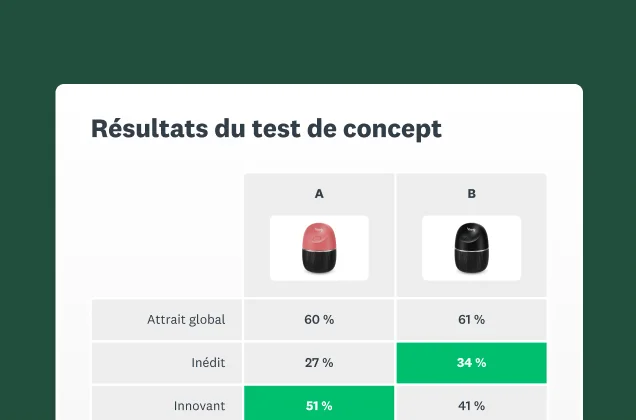
Solutions d’étude de marché
Nos études de marché conjuguent agilité et données optimisées par l’IA
Prenez de meilleures décisions en vous appuyant à la fois sur des insights client, marché et secteur. Créez un compte gratuit et collectez rapidement du feedback.





Chez SurveyMonkey, étude de marché rime avec facilité
Définissez votre population cible
Sélectionnez la population de votre choix pour obtenir une estimation. Nous enverrons votre sondage aux personnes de notre panel mondial qui correspondent à vos critères. Nous avons un réseau de 335 millions de consommateurs et professionnels répartis dans plus de 130 pays.
Notre IA s’occupe du reste
SurveyMonkey utilise l’IA pour vous guider et vous conseiller à chaque étape du sondage, de sa conception jusqu’à l’analyse des résultats.
Des insights rapides pour des décisions sûres
Notre plateforme intuitive facilite la collecte et l’analyse des données à grande échelle. Nos exigences en matière de qualité des données garantissent des réponses fiables et précises. Plusieurs formats d’exportation et des rapports personnalisés simplifient le partage des résultats sous forme de présentations prêtes à l’emploi.
Des solutions conçues par des experts
Analysez votre audience et prenez une longueur d’avance sur le marché
Identifiez de nouvelles opportunités et restez compétitif
Étudiez les préférences, les habitudes et les comportements d'achat des consommateurs.
Optimisation des prix (Van Westendorp)
Déterminez la gamme de prix optimale pour votre produit ou service.
Prenez de meilleures décisions concernant vos produits ou vos messages marketing.


Testez vos idées avant de vous lancer
Testez vos concepts produit et comparez les résultats aux benchmarks du secteur.
Testez vos idées auprès de votre population cible avant la phase de développement.
Testez différents noms pour votre marque, vos produits ou vos services.
Découvrez le concept de logo le plus efficace pour votre marque ou vos produits.
Recueillez le feedback de votre population cible sur vos concepts de packaging.
Créez des campagnes convaincantes et lancez vos produits sereinement
Testez vos campagnes marketing et publicitaires avant leur lancement.
Recueillez du feedback sur vos messages, slogans, documentations produit, etc.
Découvrez comment vos vidéos sont perçues par votre population cible.


Recevez rapidement des insights sur votre marché cible
Puisez dans un panel de 335 millions de participants répartis dans plus de 130 pays, avec plus de 200 options de ciblage. Les réponses de mauvaise qualité sont automatiquement supprimées pour que vos décisions puissent se baser sur des données fiables et actualisées.
Autres ressources à votre disposition pour aller plus loin

Les 5 phases du cycle de vie produit
Évaluez vos produits avant leur mise sur le marché avec la solution Test de concept de SurveyMonkey.

Vous avez lancé votre projet SurveyMonkey Audience. Et après ?
Découvrez ce qui vous attend lorsque vous aurez démarré votre projet et commencé à recevoir des réponses.

Quoi de neuf chez SurveyMonkey ?
Découvrez nos toutes dernières mises à jour et fonctionnalités. Créez des sondages et des formulaires pour obtenir rapidement de précieuses informations.

Test qualité de notre panel Audience
Nous garantissons que vous recevrez des réponses de sondage fiables et cohérentes.
Gardez une longueur d’avance
Lancez vos produits et services en toute confiance grâce à nos solutions d’études de marché conçues par des experts.